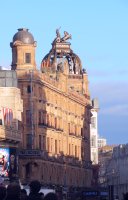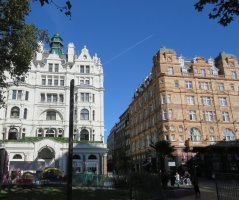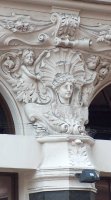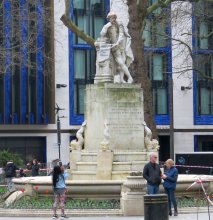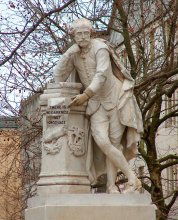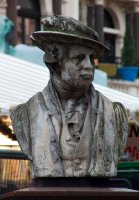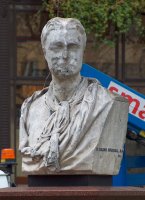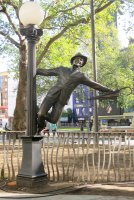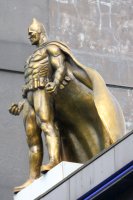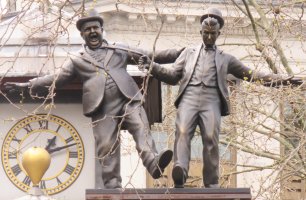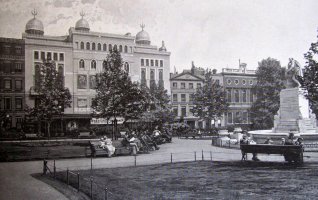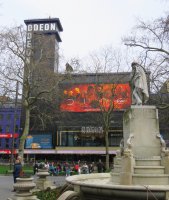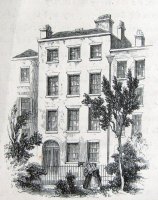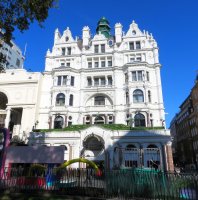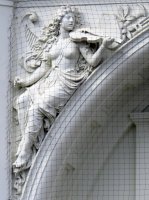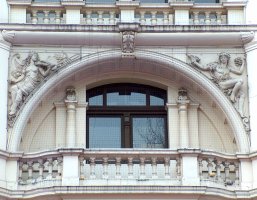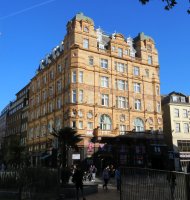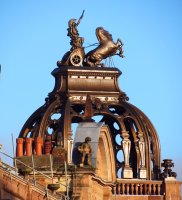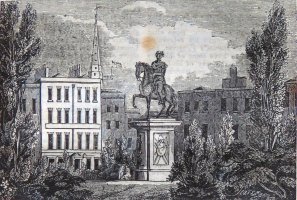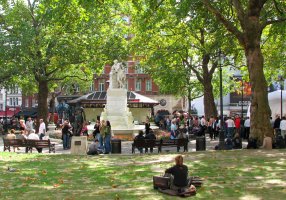Sculpture at Leicester Square
Leicester Square centres on a statue of Shakespeare, and also includes some architectural sculpture on a fine building on the north side, a bit of deco sculpture, and some entirely modern pieces. Click any picture to enlarge or hover for caption.
Shakespeare in Leicester Square, by G. Fontana.
The statue of Shakespeare
Shakespeare's statue claims the central place in Leicester Square, on top of a marble fountain, with four Classical dolphin around the base. The sculptor was Giovanni Fontana, working in the 1870s, and he copied the statue after one in Westminster Abbey, designed by the architect William Kent, and sculpted by the eminent 18th Century sculptor Peter Scheemakers. Shakespeare is in a forward-leaning pose, resting an elbow on a heap of books ,while his other hand points to a scroll with a Shakespearian quote. The plinth underneath has carved wreaths, differing from the Westminster Abbey one, which has portrait heads. The statue also differs in some of the details, and the head has not the nobleness of Scheemakers’ piece, however the pose and clothing are the same, bar an ueasiness to the forward arm which was broken and repaired slightly wrongly.
On the base of the statue is noted that the Leicester Square gardens and the statue were the gift to the nation by Baron Grant in 1874 (Baron Grant's title, apparently, was an Italian one, given to him by the City of Milan for financing the Galleria Vittorio Emanuele in that city - thank you to Stephen Grant for providing this information). Baron Grant's fortune was large - he spent £30,000 buying the square and fitting it out.
Four lost Victorian busts
As well as the central Shakespeare statue, four busts in white marble on granite pedestals, all of a similar date, were placed at the corner sites; they were present until 2011, all four in rather poor shape, and then were whipped away for ‘conservation’ by the local council and have never reappeared. They were Newton by William Calder Marshall which was the most decayed; a rather battered Sir Joshua Reynolds (the first President of the Royal Academy) by Henry Weekes; John Hunter (a pioneer of surgery) by Thomas Woolner, and a rather spirited bust of Hogarth by Joseph Durham.
Two of the busts: Reynolds and Newton.
Why were these sculptures chosen? Newton lived close by in St Martin's Street. The Scottish surgeon John Hunter opened the first Anatomical Museum in the Square in 1785 - the collection survives as the foundation of the Hunterian Museum, and he was buried in St Martin's in the Fields at Trafalgar Square. More relevantly to these artistic pages, Hogarth and Reynolds both lived in the Square.
Modern statues
Gene Kelly, Chaplin, Batman.
In the Square there is also a harmless modern statue of Charlie Chaplin (1981) by John Doubleday - he has done better things. And from 2021, a bunch of not too serious bronze statues, or bronze and resin, have been emplaced, to celebrate various film characters: Gene Kelly, Laurel and Hardie, Harry Potter and so forth; in the modern idiom, these are placed informally rather than on pedestals. Again, in modern fashion, they are produced by a company, called 3D Eye, with less focus on individual artists. One at least, Andrzej Szymczyk, Polish born but established in London, is something of a traditional sculptor; his is the Gene Kelly, Bugs Bunny, and Harry Potter; another, Pereira Ezcurra, makes superhero models, and did the Batman high up on the Odeon Cinema on the eastern side of Leicester Square; and Laurel and Hardy was made by David Field, who describes himself as a prop-maker and sculptor. Indiana Jones is the latest emplacement. Certainly these modern pieces seem to be more popular than Shakespeare for most visitors to the Square.
Laurel and Hardy.
Buildings around Leicester Square
Eastern side Leicester Square as it used to be.
Now the buildings. On the eastern side is the iconic black Odeon building, built in 1937, at nos. 23-27 Leicester Square, where in the 1850s had been the short-lived Royal Panopticon, ‘an Institution for Scientific Exhibitions and Promoting Discoveries in Art and Manufactures, which included a number of copies of famous statues, and then the Alhambra music and dance hall and later theatre. But nothing remains of that, and the Odeon itself, clad in polished black granite and with its 120ft tower (and one of those modern statues, Batman looking down - you can see him if you click the picture below to enlarge) is outside the purview of these pages.
Odeon Leicester Square 1937.
Next to the Odeon at no. 28 Leicester Square was where John Hunter had his museum from the 1780s; the building we see today is a replacement of the 1890s. And then No.30, where Hogarth once lived, is a 1950s block. When Hogarth lived there, from 1733, he placed a bust – his only sculptural work – above the door. After he died, his widow remained until her death in 1789. The following year, Hogarth's remaining pictures were auctioned in the Square, at a tavern there, achieving a total of £255. As an example, 'a parcel of Academy figures and studies' went for 11 shillings and sixpence.
Hogarth, Reynolds and St John's Hospital
On the south side, in the bit of Green Street facing Leicester Square, are more late 1890s buildings. And the west side, all modern now, was where Sir Joshua Reynolds, President of the Royal Academy, lived in a fine house at no.47 Leicester Square, from 1760-1792; his pupil and follower Sir Thomas Lawrence was also there for a time. Next to his house was later built St John's Hospital, a late Victorian building in rather a free style with elements of Elizabethan and early Arts and Crafts, by the architectural partnership Treadwell and Martin; it had a fair bit of architectural sculpture, including a bust at the balcony high up, and above that, a standing female figure, perhaps Hygeia.
The present buildings of most interest to these pages are on the north side, where once was Leicester House, built by Robert Sidney, Earl of Leicester, and from whom the Square gets its name. That building was put up in the 1630s, among fields, and it was a generation later when the Square took shape, with the first rows of houses appearing in the 1670s.
The Empire, with its enormous Venetian arch, and decorative tilework in blue and cream, was put up in 1927-28, being a collaboration of the New York theature architect Thomas W. Lamb, and Frank Matcham & Co, the company of the famous British theatre architect, which continued after his death in 1920. This building replaced an earlier Empire Theatre of the 1880s, and was itself reconstructed behind the original entrance in the early 1960s.
Queen's House (Empire arch to left).
Next to the Empire Theatre, on the right as we look from the Square, at 7-9 Leicester Square, is a jolly white-painted building called Queen’s House, next to Leicester Place leading out to the north. It bears the date 1897, and was designed by Messrs. Saville and Martin as the Queen's Hotel, opening in 1899, all very French in style. Under the white paint is Portland stone, and the whole frontage is a complex mix of bay windows, balconies, tall dormers and lots of columns, and plenty of decorative carving.
Carving on Queen's House, 7-9 Leicester Square.
Looking above the central portico, we have 5 storeys including the dormer, and on the second storey is a round arch above a balcony, with seated figures in the spandrels. A semi-nude figure of Music to the left plays a violin, while in the background are a horn, tambourine, and some sort of harp: she has long snakelike hair with a crown of leaves, a very Bacchanalian figure. And indeed, facing her on the other side is a nude Bacchus holding a cup and bunch of grapes, wearing only a lionskin over his shoulder and tied by the paws. The bays to left and right have carved heads in the keystone positions and under the pillars. The next floor up, we have Ionic capitals in the centre, over scrolls with lion heads, and on the side bays, half-figure Caryatids, with cherub friezes below. Higher still are various shields and small heads, and a splendid roofline with little pots and domes, chimneys and spikes, and a curious little sphinx at the corner. Down at the ground floor, the red granite pillars are left unpainted, and the Corinthian capitals are decorated with female heads and shields, which can be readily appreciated close up. All entirely appropriate for a palace of entertainment.
The alley next to the building, Leicester Place, at one time was home to the Panorama of 1792-93, with vast pictures erected in a cylindrical hall, including one of the Battle of Waterloo, and various views of exotic foreign cities, and this lasted through until the 1860s. A French Catholic church was then built here, still with a circular plan, and when that perished in World War II bombing, its 1950s replacement again was given a circular interior, which is worth a small detour to see.
Victory House, 14-15 Leicester Square.
Back into Leicester Square, across Leicester Place from the former Queen’s Hotel is another former hotel, in rather different style: 14-15 Leicester Square, called Victory House, in bright terra cotta. French domes at the top, flanking two levels of mansard windows above a balustrade, then four storeys above the ground floor, of which the lowest has round-headed arches and little round windows, and the next up has a relief frieze. The terracotta modelling on that frieze includes lots of scrolling, and a few faces, and the round windows below are surrounded by cartouche-effect frames with scrolling and grotesque faces. An architect’s design, to give a sense of decoration without anything to really keep the gaze. The date is 1897-98 again.
Hippodrome from along Cranbourn Street.
So this terra cotta building is the last on the north side to face into Leicester Square, and next along is the beginning of Cranbourn Street: standing here and looking along that street gives a view first of the late 1930s Warner Cinema which has relief figures of a man and a woman in motion - very much of the deco period, and at the end, a fine view of the chariot and horses on top of the Hippodrome on Charing Cross Road (again by the theatre and music hall architect Frank Matcham), dating from the turn of the century.
The connection of Leicester Square with the cinema goes back a long way as we have seen. As well as the 1790s Panoramas, another circular building occupied the centre of the square for a while in the 1850s. This was Wyld's Great Globe, an ambitious display with a 10,000 sq ft representation of the world painted inside. Scaffolding allowed visitors to climb up and view any part of the world they wished. In 1854 a scale model of the Crimea was installed, so that the positions of the armies could be plotted daily as news came in. An Oriental Museum also exhibited here in the late 1850s.
George II, the doomed statue (see text).
We may mention another sculpture which came to a cruel end in Leicester Square. when the Earl of Leicester had his mansion on the site, other fashionable folk moved nearby, and it was they who wished to buy a statue of the current monarch (George II). What they bought was in fact an equestrian statue of George I, sculpted by C. Buchard, with the horse modelled on that by le Sueur in Trafalgar Square. Considered a great work of art at the time, George I and his horse were gilded and placed in the centre of the square. Alas, over time the Square became less fashionable, the well-to-do moved out, and the area went downmarket. By the time the Panorama and Wyld's Great Globe had closed down, the Square had become a dumping ground for rubbish, and the statue had fallen into ruin. First the arms dropped off. Then the legs went missing. Someone took the head away, and then the dismembered torso was wrenched off the horse and propped up against it. The final blow came when persons unknown whitewashed the horse and painted black spots on it to make it look like a cow. The remains were soon afterwards destroyed.
Well so much for that. We end with a final little group of buildings, easily overlooked. In the north east corner of Leicester Square, just by Cranbourn Street, back on the East side of Leicester Square where we started Here are nos. 19 Leicester Square, rebuilt, and the original though damaged in World War II no.20, where James Tassie, the gem-carver and cast-maker and wax modeller of portraits of the great and good, lived between 1778-99. His house was later brought together with no. 21 Leicester Square to make a hotel. And then no.22 Leicester Square, another plain-fronted little building of 4 storeys, 3 windows wide, still as it was in the 1770s. This little group then, and perhaps the similar-looking no.1 Cranbourn Street, remain from before any of the places of entertainment arrived, when there was just Leicester House to the north side of what was still Leicester Fields.
South to Trafalgar Square // West to Piccadilly Circus and Eros statue // East to Charing Cross Road
